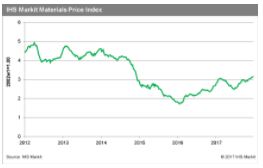| Week ending January 12, 2017 |
Commodity prices continue to rally
|
Commodity prices are having a strong start to 2018.
The IHS Markit Materials Price Index (MPI) increased for the ninth consecutive week to start 2018, jumping 2.8%—its strongest weekly gain since early September. The rise was broadly based, with eight of ten subcomponents rising. Ferrous metals and oil prices were among the biggest movers, increasing 4.8% and 2.4%, respectively.
Oil prices continued to rise last week as political unrest in Iran worried the market. A strong draw on US inventories, caused in part by near-record-level crude runs, also put upward pressure on prices. In ferrous metals, weather in Australia disrupted shipping, while steel production in China fell; both factors contributed to stronger finished steel and steel-making raw material prices.
The December US employment report and December's purchasing managers' indexes (PMIs) for manufacturing dominated last week's data releases and reinforced the already buoyant mood in markets. US job growth came in under expectations, although the overall report still showed the US labor market heading into 2018 on a solid footing. December's manufacturing PMIs highlighted a strong, continuing expansion in global manufacturing activity, with the headline index hitting an 82-month high.
Despite the evident strength in commodity markets, we feel a combination of slower growth in China, tighter financial markets, and lower oil prices will cap any further rise in prices. The test for this view will come late in the first quarter, when Chinese buyers return from the prolonged holiday season and some of the supply bottlenecks currently affecting markets are resolved. If commodity prices are still showing strength, this would be a worrisome sign that accelerating inflation downstream in supply chains lies ahead.
|
|
|
| | IHS Materials Price Index |  |
|
| | 
| Market Insight
For an overview of the IHS Materials Price Index, view this video.
Get the Materials Price Index delivered to your in-box weekly.
Subscribe here.
|
|  |
| | |
|
| Industrial Materials: Prices |  |
| Key Prices & Demand Drivers |  |
Construction Labor Costs Reach Highest Level in Almost Three Years, IHS Markit Says
|
Construction costs rose again in November, according to IHS Markit and the Procurement Executives Group (PEG). |
The current headline IHS Markit PEG Engineering and Construction Cost Index registered 60.2, supported by strong figures in both the materials/equipment and labor sub-indexes. The materials/equipment price index was 60.9 in November, moving up from the October figure of 58.9. Price increases were widespread. Current subcontractor labor prices rose at a fast pace in November: the index figure came in at 58.5, the highest reading since December 2014. “Subcontractor rates continued to accelerate over November and expectations for future increases reached a five-year high,” said Emily Crowley, principal economist - pricing and purchasing, IHS Markit. “Tightening labor market conditions combined with an uptick in activity are driving expectations of future rate increases. Currently the U.S. South and West are having the most trouble finding workers leading to stronger wage escalation, whereas the end of major projects in Eastern Canada are keeping pressure off of wages in that region.”
| | Learn More |
|
| About IHS Pricing & Purchasing | | The IHS Pricing & Purchasing Service | The IHS Pricing & Purchasing Service enables supply chain cost savings by providing timely, accurate price forecasts and cost analysis. Armed with a better understanding of suppliers' cost structures and market dynamics, organizations can effectively negotiate prices, strategically time buys, and boost the bottom line.
With a database of more than 80,000 historic prices and thousands of price, wage and input cost forecasts, IHS offers more coverage than any other provider in the market. IHS has been providing forecasts of key commodity, labor, and input costs since 1970 -- helping define the purchasing advice industry. | | Learn More |
|
| Commodity Price Forecasts & Supply Chain Cost Benchmarking. Learn More | | |
|
|
|
